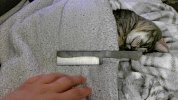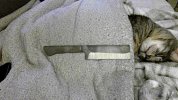- Joined
- Feb 13, 2019
- Messages
- 9
So, I have a question about how to fix a grind that I'm doing, that varies a bit on both sides. A little extra info: I'm a new knifemaker without much experience, I'm working on a 4x36 harbor freight belt grinder with ceramic belts that I got from Trugrit. My work rest I had to modify a bit because it wasn't quite big enough/didn't clear portions of the beltgrinder that I can't change, and so I kept hitting lips and edges, so my workrest is pieces of plywood screwed together. I also just started using a new bevel jig that I made today on this knife as well.
As you can see in the pictures (Ignore the sleeping cat, I took the pictures in my bedroom) one side of my knife has a very interesting curving bevel line. Admittedly that wasn't my intention, but it actually turned out kind of unique looking. The other side, has a straighter line, that dips up a bit near the edge of the blade.
At this point I figure that I can't really make the straight side, into a curving line like the other side, so I'm looking to just straighten out the curving side a bit. That being said, I'm not entirely sure how to do it, I'm also not sure how I wound up with the bevel line curving like it did. I applied even pressure throughout my grind, and I didn't change the angle of the blade against the belt at all. I did the same method and angles, as well as pressure, for both sides and wound up with two different grinds.
I've tried working on the curved side and adding a little extra pressure on the portion of the line that curves down into the bevel, but it doesn't seem to do anything. So what would be the best way to fix this? And how can I avoid something like this in the future? Since I thought that I used the same pressure and angles on both sides, I shouldn't have gotten two different lines, so any advice for my future grinds to try and stop this from happening again?

As you can see in the pictures (Ignore the sleeping cat, I took the pictures in my bedroom) one side of my knife has a very interesting curving bevel line. Admittedly that wasn't my intention, but it actually turned out kind of unique looking. The other side, has a straighter line, that dips up a bit near the edge of the blade.
At this point I figure that I can't really make the straight side, into a curving line like the other side, so I'm looking to just straighten out the curving side a bit. That being said, I'm not entirely sure how to do it, I'm also not sure how I wound up with the bevel line curving like it did. I applied even pressure throughout my grind, and I didn't change the angle of the blade against the belt at all. I did the same method and angles, as well as pressure, for both sides and wound up with two different grinds.
I've tried working on the curved side and adding a little extra pressure on the portion of the line that curves down into the bevel, but it doesn't seem to do anything. So what would be the best way to fix this? And how can I avoid something like this in the future? Since I thought that I used the same pressure and angles on both sides, I shouldn't have gotten two different lines, so any advice for my future grinds to try and stop this from happening again?



